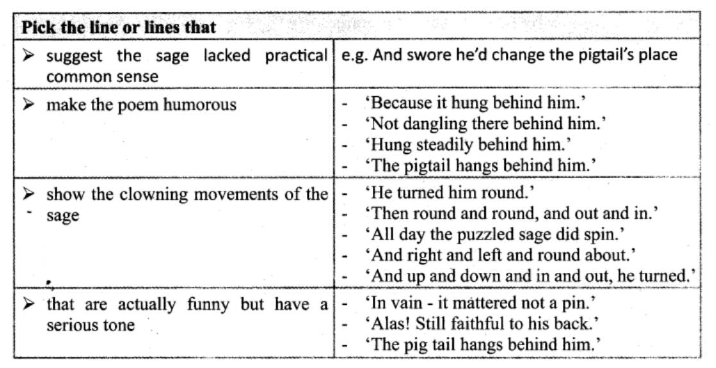Samacheer Kalvi 6th English Solutions Term 3 Poem Chapter 2 A Tragic Story
Poem Chapter 2 – A Tragic Story

Poem Overview:
| Line No. | Poem Lines | Explanation |
| 1-2 | ‘There lived a sage in days of yore, And he a handsome pigtail wore; | Long ago, there lived a sage and he had a beautiful pigtail. |
| 3-4 | ‘But wondered much and sorrowed more, Because it hung behind him. | He wondered much about his pigtail’s position and was worried more, as it hung behind him. |
| 5-6 | ‘He mused upon this curious case, And wore he’d change the pigtail’s place,’ |
He thought about this curious case and promised that he would change the position of the pigtail. |
| 7-8 | ‘And have it hanging at his face, Not dangling there behind him.’ | He would like to have it on his face and not swinging loosely behind him. |
| 9-10 | ‘Says he, “The mystery I’ve found- Says he, “The mystery I’ve found! ’ |
The sage insists that he has found a solution to change the position of his pigtail. |
| 11-12 | ‘I ’ll turn me round, ’’ he turned him round; But still, it hung behind him.’ | He said that he would turn him round and so he turned him round. But still, it hung steadily throughout the day. |
| 13-14 | ‘Then round and round, and out and in, All day the puzzled sage did spin;’ | The confused sage turned round and round, out and in continuously throughout the day. |
| 15-16 | ‘In vain-it mattered not a pin- The pigtail hung behind him.’ | Even though he turns continuously the whole day, it still hangs firmly behind him. |
| 17-18 | ‘And right and left and roundabout, And up and down and in and out ’ | He turned to his right and left and roundabout again. He turned up and down and in and out. |
| 19-20 | ‘He turned, but still, the pistol stout Hung steadily behind him’ | He turned and turned, but still, the pigtail remained thick and hung steadily behind him. |
| 21-22 | ‘And though his efforts never slack, And though hi twist and twirl and tack’ | Though his efforts were not slackened and though he twisted, twirled and tacked. |
| 23-24 | Alas! still faithful to his back The pigtail hangs behind him’ |
The poet expresses his sorrow in a humorous way and says that though he tried his best to change the position of his pigtail, it remained faithfully behind him. |
A. Answer the following.
Answer:
The sage was upset, as his pigtail hung behind him.
Answer:
He span continually all day to change the position of his pigtail.
3.What solution did he arrive at for the mystery that he found?
Answer:
He thought that if turned him round, he can change the position of his pigtail.
4. Was he finally successful in changing his pigtail’s position? Support your answer with a line from the poem.
Answer:
No, he was not successful in changing his pigtail’s position. The line ‘Still faithful to his back, the pigtail
hangs behind him’ supports this answer.
Answer:
No, nothing dreadful happened. The events in the poem are humorous. The illogical behaviour of the sage
creates humour throughout the poem.
B. Read the poem lines and answer the questions given below.
a. What was he wondering about?
Answer:
He was wondering about why his pigtail is behind him and how to change its position.
b) What does the word ’it’ refer to here?
Answer:
‘It’ refers to the Pigtail here.
2. And though his efforts never slack And though he twist, and twirl, and tack,
Alas! Still faithful to his back
The pigtail hangs behind him.
a) Pick out the rhyming words from the above lines and give the rhyme scheme for the same?
Answer:
Rhyming words: sack – tack – back
Rhyme scheme: a a a b
b) Did he quit his trying? How can you say?
Answer:
No, he did not quit his trying. The lines ‘And though his efforts never slack. And though he twists and twirls and tacks” shows that he did not stop his trying.
3. ‘He mused upon this curious case’
what is the figure of speech used in this line?
Answer:
The figure of speech used here is hyperbole, as it exaggerates the simple foolish thing of changing the position of his pigtail to a curious case.
4. Irony is a figure of speech in which words are used in such a way that their intended meaning is different from the actual meaning. It may also be a situation that ends up quite different from the actual meaning. It may also be a situation that ends up in quite a different way than what is generally anticipated. In simple words, it is a difference between appearance and reality.
Can this poem be called an ironic poem? Justify your answer.
Answer:
Yes, this poem is an ironic poem because the word ‘sage’ is used in an ironic sense to refer to a person who is dull-witted. It insists on how learned men lack practical sense.
Explanation:
This poem can be called an ironic poem. The character in this poem is a wise man. He has a handsome Pigtail. Naturally, it will hang behind the person. In spite of being wise, he decides to change his position. He knows it well. But he tries to change its position. He wants it to hang on his face.
How funny the idea is! The ways he follows to changes its place are full of irony. He turns him round and round, out and in, he spins all day. It all ends in vain. But he does not want to give up his trying. The poet ends the poem by saying. The Pigtail remains faithful to his back. So the poem ends with irony.
C. Fill in the table with the appropriate poem lines. A few lines may be used more than one time. (Text Book Page No. 108)

D. The summary of the poem is given. But there are some words missing. Fill in the blanks with the help of the box given below. (Text Book Page No. 108)
faithfully, change, pigtail, round, sage, down, slack, out, hung, place, behind, wain, face
Once upon a time, there lived a sage. He had a handsome pigtail. He was worried and pondered over his pigtail’s place. He wanted to change its place. He wanted it hanging on his face. He didn’t like it hanging there behind him. So he turned right and left and roundabout, up and down, and in and out but it still hung behind him. However he tried, his efforts were in vain. But he didn’t slack in his efforts. Nevertheless, his pigtail hung faithfully behind him.
A Tragic Story About the Author in English
William Makepeace Thackeray (18 July 1811 – 24 December 1863) was an English novelist of the 19th century. He was famous for his satirical works, particularly. Vanity Fair, a panoramic portrait of English society.
A Tragic Story Summary
The poem ‘A tragic story’ written by William Makepeace Thackeray is a humorous poem which revolves around a foolish act done by a sage. Throughout the poem, the poet laughs at this wise man, who does not have any practical knowledge, but uses his theatrical knowledge and does foolish things.
The poet narrates to us about a sage, who lived in the past with a beautiful pigtail. He was worried about his pigtail, being hung behind him. He thought about this for a long time and swore that he would change the pigtail’s place, which is apparently impossible and funny.
He would like to have it on his face and not dangling there behind him. This small thing is a serious problem for this wise man. He said that he had found a solution to change the position of his pigtail. So he turned him round continuously without stopping, throughout the day. He turned in different directions – he turned right and left, out and in, up and down. But the pigtail didn’t change a bit. Though his efforts were not slackened, and though he twisted, twirled, and tacked, his pigtail hung faithfully and steadily behind him. Thus, this poem is amusing and the poet brings out the theme
“How learned man lacks practical common sense.”
A Tragic Story Additional Questions
I. Poem Comprehension and Poetic Devices.
1. ‘There lived a sage in days of yore,
And he a handsome pigtail wore ’.
a. Who lived long ago?
Answer:
A sage lived long ago.
b. What did he have?
Answer:
He had beautiful pigtail.
c. Pick out the rhyming words in these lines.
Answer:
The rhyming words are ‘yore – wore’.
2. ‘And swore he’d change the pigtail s place,
And have it hanging at his face
Not dangling there behind him.
a. What did the sage swear?
Answer:
He swore that he would change his pigtail’s place.
b. Where did he want to have it?
Answer:
He wanted to have it hanging on his face.
c. Pick out the alliterated words in these lines.
Answer:
The alliterated words are:
(1) pigtail’s – place
(2) have – hanging – his
3. ‘Then round and round, and out and in
All-day the puzzled sage did spin;
In vain – it mattered not a pin
The pigtail hung behind him.
a. What did the sage do?
Answer:
He turned round and round, out and in all day.
b. Why was the sage puzzled?
Answer:
He was puzzled because he could not change the position of his pigtail, even though he turned round and round all day.
c. What Is the rhyme scheme of the poem?
Answer:
The rhyme scheme is ‘a a a b’.
4. ‘Alas! Still faithful to his back’.
a. Who Is faithful?
Answer:
The pigtail is faithful.
b. Why did the poet use the word, Alas’?
Answer:
He criticizes the sage’s ignorance and pities him in a serious tone, using the word ‘Alas’.
c. Whose back is referred to here?
Answer:
The back of the sage is referred to here.
Important Links:
Text BOOK For Competitive Exams
Previous Year Question Papers Download
Tamil Nadu Government Exam Notes:
- Mental Ability Test Book PDF
- TNPSC (GROUP 1,2,2A) Preliminary UNIT VIII ( ii. Thirukkural) material free download
- TNPSC Exam Materials (Group 1,2,2A) – Tamil Nadu Commissionerate of Employment & Training
- TNPSC Group 2, 2A Model Test Paper 2021- Tamil Nadu Government
- TNPSC Free Government Material PDF Download All subjects | GROUP 4 Exam | Tamil and English Medium
- TNPSC GROUP 2 2a Exam Free Government Material PDF Download All subjects | Tamil and English Medium
- TNPSC GROUP 1, 2, 2a, 4 Exam Free Government Material PDF Download All subjects | Tamil and English Medium
TNPSC Previous year question papers collections in single PDF
Mental Ability
- simple Interest
- Compound Interest
- LCM & HCF
- Percentage
- Mensuration 2D
- Mensuration 3D
- Profit & Loss
- Ages
- Ratio
- Simplification
- Statistics & Probability
- Time & Work
- TNPSC பொதுதமிழ் Previous year question with Answer combined pdf
- TNPSC Previous year Question paper 2020 – All exam Question and Answer in One pdf
- TNPSC PREVIOUS YEAR QUESTION PAPERS (2013 TO 2020) – History, Botony, Zoology, Physics, Chemistry, Polity, Economics
Other Important Links:
RRB RAILWAY RECRUITMENT BOARD (RRB NTPC) material free download
Tags:
6th english book back questions and answers samacheer kalvi,samacheer kalvi 6th english book back answers,samacheer kalvi 6th english book answers,samacheer kalvi 6th english answer key,samacheer kalvi english 6th guide,samacheer kalvi guru english 6th standard,6th samacheer english book back answers,6th english guide samacheer kalvi,6th samacheer kalvi english book pdf,6th standard english samacheer kalvi,6th standard english guide samacheer kalvi,6th english samacheer kalvi,6th english samacheer guide,6th standard english samacheer kalvi guide,6th std english samacheer kalvi,tn 6th english guide,tn samacheer 6th english guide,tn 6th english book pdf,tn 6th std english book,tn 6th english book,6th samacheer kalvi english guide,6th english book back answer,samacheer kalvi 6th english book back solutions,samacheer kalvi english guide for 6th std,samacheer kalvi 6th standard english book answers,samacheer kalvi 6th std english book back answers,6 std english book back answers,6th std english book back answer,6th term 3 english book back answers,6th standard 3rd term english book back answers,6th std term 3 book back answers,6th std term 3 english guide,6th standard term 3 english guide,6th std samacheer kalvi english guide,6th english samacheer kalvi guide,book back answers for 6th english,6th samacheer kalvi english,6th samacheer english,6th samacheer english guide,6th samacheer english book back questions and answers,7th samacheer english book back answers,

